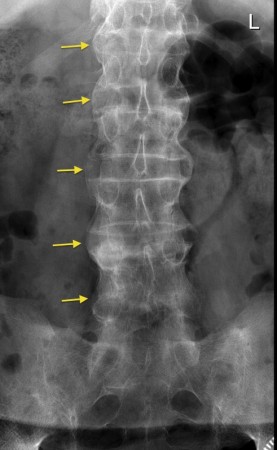

Lastly, protein deposits (amyloid) in the kidneys from AS may lead to kidney failure in patients with the disease.Īnkylosing Spondylitis (AS) Diagnosis & Treatment AS may also cause scarring in certain tissues of the heart, which in turn slows down the patient’s heart rate. Iritis is easily identifiable by the redness and pain of the affected eye, which exacerbates when the patient is looking at bright lights. Some patients with AS may develop iritis (inflammation of the iris). Other areas affected by the condition are: the heart, eyes, and kidneys. As you can see, breathing becomes a major problem with AS. Additionally, these problems affect where the ribs attach to the upper thoracic spine, which further decreases the patient’s lung capacity. This limits the patient’s ability to breathe properly. Usually, the pain manifests suddenly when a spinal fracture such as this occurs.īoth spondylitis and ankylosis cause forward spinal curvature of the thoracic region. This new bamboo-like spine is quite brittle and vulnerable to fractures via trauma, such as with contact sports activities. When this happens, the pain disappears, but at the steep price of losing all spinal mobility. In severe cases involving the spine, a complete bony fusion between vertebrae may occur. Additionally, the onset of these symptoms tends to be rapid and intense. Usually, these symptoms are progressive, meaning that they only worsen with time and ultimately lead to a loss in overall range of motion. Of course, these symptoms may affect other parts of the spine as well. Spinal inflammation causes both stiffness and pain in the lumbar region, as well as the cervical area and upper buttocks. With active inflammation, fatigue often accompanies the symptoms of AS. The symptoms of AS are associated with the inflammation and arthritis in several different parts of the body, being: the spine, joints, and certain organs. Ankylosing Spondylitis (AS) Signs & Symptoms
Bamboo spine how to#
The medical community is actively researching the disease to better understand how it works and how to best treat it. The main point is that the disease is only understood in bits and pieces currently. Perhaps the disease came into play because of the body’s immune functions, or maybe it spawned from some sort of bacterial infection. It is a very complicated ordeal, as every individual seems to have their own manifestation of the disease. It is still not well understood how the disease occurs and spreads to entirely different areas across the body. The medical community generally accepts this as a notable risk factor for developing the disease. This belief exists mainly because these genes affect the way our body’s immune system works. Medical experts also suggest that genes ARTS1 and IL23R are responsible for the manifestation of AS. So, while the gene is commonly found in patients who have the condition, it is certainly not the only factor at play. That being said, only 1% of the population actually goes on to develop AS. In the United States, 7% of people have the gene in question. The reason for this belief is because of the way the numbers stack up. Studies show that additional factors-likely environmental-must be present in order for the disease to manifest. Of course, having this gene isn’t necessarily a sentence for developing AS. In doing so, our understanding of the gene’s association with this condition has improved dramatically. In recent years, the medical community has developed blood tests to screen for this gene. The vast majority of AS patients are those who were born with the gene HLA-B27.

The medical community widely believes that ankylosing spondylitis develops because of a genetic predisposition. The spine develops a bamboo-like appearance because of the joining of adjacent discs. Indeed, this is where the term “bamboo spine” comes from. More accurately, AS causes the exterior fibers of the annulus fibrosus in our intervertebral discs to ossify, which leads to a spine that appears fused between each vertebra. In fact, when vertebrae completely fuse together, this is known as ankylosis. In rare cases, AS may even cause the spinal vertebrae to fuse. AS leads to spine-stiffening and inflammation in the joints.

Usually, AS attacks the spine and sacroiliac joints, but it can also adversely affect other joints and organs as well. Ankylosing Spondylitis (AS) is a chronic inflammatory disease that affects multiple systems throughout the body.


 0 kommentar(er)
0 kommentar(er)
